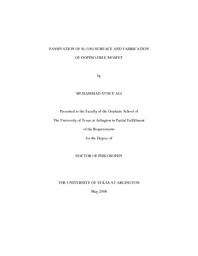
ATTENTION: The works hosted here are being migrated to a new repository that will consolidate resources, improve discoverability, and better show UTA's research impact on the global community. We will update authors as the migration progresses. Please see MavMatrix for more information.
Show simple item record
| dc.contributor.author | Ali, Muhammad Yusuf | en_US |
| dc.date.accessioned | 2008-09-17T23:34:53Z | |
| dc.date.available | 2008-09-17T23:34:53Z | |
| dc.date.issued | 2008-09-17T23:34:53Z | |
| dc.date.submitted | May 2008 | en_US |
| dc.identifier.other | DISS-2093 | en_US |
| dc.identifier.uri | http://hdl.handle.net/10106/1019 | |
| dc.description.abstract | Chalcogen atoms have been successfully used for the passivation of GaAs(100) as well as Ge(100) and Si(100) substrates. Unlike GaAs(100) and Ge(100), the native oxide(SiO2) of Si(100) substrate is not soluble in ammonium sulfide solution ((NH4)2Sx) or water, which is a major problem to passivate Si(100) surface in a solution.
In this work, a wet chemical process has been developed in which a compatible etchant ammonium hydroxide (NH4OH) is added with a passivating solution ((NH4)2S). Because of the compatibility of the etchant with the passivating solution, native oxide on Si(100) surface is removed in-situ to expose a fresh and clean surface, right before the surface is passivated by the passivating solution. To characterize the passivated surface, Schottky contacts have been fabricated using different work function metals (Al, Ni, Ti, Cr) on Si(100) substrate. The Schottky diodes were characterized by current-voltage, capacitance-voltage and activation-energy measurements. Due to the passivation of Si dangling bonds by S, surface states are reduced to a great extent and Schottky barriers formed by those metals on Si(100) substrates show greater sensitivity to their respective work functions. S-passivation provided very low barrier height(<0.11 eV) with Al on n-type Si(100) and the highest barrier height(~1.1 eV) with Al on p-type Si(100).
A new doping-free MOSFET structure is also proposed in this work. In this doping-free MOSFET, the high temperature doping step(~1000o C) that is required to form the source/drain contact in a conventional MOSFET is replaced by more energy efficient passivation technique(maximum ~500o C). The energy dissipated in a high-temperature process is directly proportional to the fourth power of its absolute temperature(µ T4). By reducing the process temperature from 1,000°C to 500°C, the energy consumption can be cut by a significant amount. 2-D device simulations show that the doping-free MOSFET has similar performance characteristics provided by the conventional MOSFET but with the additional advantages of process simplicity and energy savings. Though fabricated devices show a maximum current drive of ~2´10-7 A/mm and low on/off ratio, suggestions have been provided to improve the performance characteristics and to achieve ideal characteristics as predicted by the simulation results. | en_US |
| dc.description.sponsorship | Tao, Meng | en_US |
| dc.language.iso | EN | en_US |
| dc.publisher | Electrical Engineering | en_US |
| dc.title | Passivation Of Si (100) Surface And Fabrication Of Doping-free MOSFET | en_US |
| dc.type | Ph.D. | en_US |
| dc.contributor.committeeChair | Tao, Meng | en_US |
| dc.degree.department | Electrical Engineering | en_US |
| dc.degree.discipline | Electrical Engineering | en_US |
| dc.degree.grantor | University of Texas at Arlington | en_US |
| dc.degree.level | doctoral | en_US |
| dc.degree.name | Ph.D. | en_US |
| dc.identifier.externalLink | https://www.uta.edu/ra/real/editprofile.php?onlyview=1&pid=291 | |
| dc.identifier.externalLinkDescription | Link to Research Profiles | |
Files in this item
- Name:
- umi-uta-2093.pdf
- Size:
- 1.494Mb
- Format:
- PDF
This item appears in the following Collection(s)
Show simple item record


